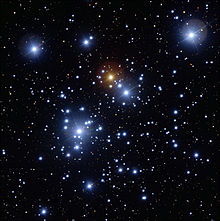DU 크루시스
DU Crucis| 관찰 데이터 Epoch J2000 Equinox J2000 | |
|---|---|
| 콘스텔레이션 | 십자형 |
| 적경 | 12h 53m 41.33485s[1] |
| 적위 | - 60° 20° 57.9647°[1] |
| 겉보기 등급(V) | 7.45[2] |
| 특성. | |
| 스펙트럼형 | M2-Iab[3] |
| U-B 색지수 | +2.57[2] |
| B-V 색지수 | +2.22[2] |
| 변수 유형 | Lc[4] |
| 아스트로메트리 | |
| 반지름 속도(Rv) | - 21.24[5] km/s |
| 고유운동(μ) | RA: - 4.703[6] mas/년 Dec.: -1. 1년[6] 동안 1년 동안 1회 이상 |
| 시차()) | 0.5075 ± 0.0516 mas[6] |
| 거리 | 2,600[7][8] pc |
| 절대 등급(MV) | - 5.52[9] |
| 상세[9] | |
| 반지름 | 568[10] R☉ |
| 광도 | 52,000 ~ 53,000[10] |
| 온도 | 3,440±170[10] K |
| 기타 명칭 | |
| 데이터베이스 참조 | |
| 심바디 | 데이터. |
도가니자리 DU는 산개성단 NGC 4755에 있는 적색 초거성으로 느리고 불규칙한 변광성으로, 카파()) 십자성단 또는 보석상자성단으로도 알려져 있다.
위치
DU Cruis는 보석상자 성단에서 가장 밝은 적색 초거성 중 하나이며, 다른 밝은 [11]초거성인 청색 초거성과는 매우 대조적입니다.성단 중앙에 있는 눈에 띄는 문자 "A"자 모양의 별자리 중앙 막대의 일부입니다.이 성단은 더 큰 센타우루스 OB1 성협에 속하며 약 8,500광년 떨어져 있다.
이 성단은 남십자성의 왼쪽 별인 β Crucis의 남동쪽에 있다.
특성.
DU Cruis는 M2 중간 광도 초거성(광도 등급 Iab)입니다.낮은 온도에도 불구하고, 그것은 매우 큰 크기 때문에 태양의 46,600배 광도이다.§ 크루시스 성단의 나이는 1120만 [7]년으로 계산된다.
가변성
히파르코스 위성 임무의 광도 측정 결과 크루시스의 밝기는 0.44 [13]등급으로 변화했다.변이에서 주기성은 검출되지 않았으며, Lc형의 느린 불규칙 변광성으로 분류되어 [4]초거성을 나타낸다.
레퍼런스
- ^ a b van Leeuwen, F. (November 2007), "Validation of the new Hipparcos reduction", Astronomy and Astrophysics, 474 (2): 653–664, arXiv:0708.1752, Bibcode:2007A&A...474..653V, doi:10.1051/0004-6361:20078357, S2CID 18759600.
- ^ a b c Dachs, J.; Kaiser, D. (November 1984), "UBV photometry of the southern galactic cluster NGC 4755 = Kappa Crucis", Astronomy and Astrophysics Supplement Series, 58: 411–429, Bibcode:1984A&AS...58..411D.
- ^ Keenan, Philip C.; McNeil, Raymond C. (1989). "The Perkins catalog of revised MK types for the cooler stars". Astrophysical Journal Supplement Series. 71: 245. Bibcode:1989ApJS...71..245K. doi:10.1086/191373. ISSN 0067-0049.
- ^ a b Samus, N. N.; Durlevich, O. V.; et al. (2009). "VizieR Online Data Catalog: General Catalogue of Variable Stars (Samus+ 2007-2013)". VizieR On-line Data Catalog: B/GCVS. Originally Published in: 2009yCat....102025S. 1. Bibcode:2009yCat....102025S.
- ^ Mermilliod, J. C.; Mayor, M.; Udry, S. (2008). "Red giants in open clusters. XIV. Mean radial velocities for 1309 stars and 166 open clusters". Astronomy and Astrophysics. 485 (1): 303–314. Bibcode:2008A&A...485..303M. CiteSeerX 10.1.1.30.7545. doi:10.1051/0004-6361:200809664.
- ^ a b c Brown, A. G. A.; et al. (Gaia collaboration) (August 2018). "Gaia Data Release 2: Summary of the contents and survey properties". Astronomy & Astrophysics. 616. A1. arXiv:1804.09365. Bibcode:2018A&A...616A...1G. doi:10.1051/0004-6361/201833051. VizieR에서 이 소스에 대한 Gaia DR2 레코드.
- ^ a b Aidelman, Y.; Cidale, L. S.; Zorec, J.; Arias, M. L. (2012). "Open clusters. I. Fundamental parameters of B stars in NGC 3766 and NGC 4755". Astronomy & Astrophysics. 544: A64. Bibcode:2012A&A...544A..64A. doi:10.1051/0004-6361/201219069.
- ^ Corti, M. A.; Orellana, R. B. (2013). "Members of Centaurus OB1 and NGC 4755: New spectroscopic and astrometric studies". Astronomy & Astrophysics. 553: A108. Bibcode:2013A&A...553A.108C. doi:10.1051/0004-6361/201220743.
- ^ a b Harris, G. L. H. (1976). "Evolved stars in open clusters". Astrophysical Journal. 30: 451. Bibcode:1976ApJS...30..451H. doi:10.1086/190368.
- ^ a b c Messineo, M.; Brown, A. G. A. (2019). "A Catalog of Known Galactic K-M Stars of Class I Candidate Red Supergiants in Gaia DR2". The Astronomical Journal. 158 (1): 20. arXiv:1905.03744. Bibcode:2019AJ....158...20M. doi:10.3847/1538-3881/ab1cbd. S2CID 148571616.
- ^ Kharchenko, N. V.; Piskunov, A. E.; Röser, S.; Schilbach, E.; Scholz, R.-D. (2004). "Astrophysical supplements to the ASCC-2.5. II. Membership probabilities in 520 Galactic open cluster sky areas". Astronomische Nachrichten. 325 (9): 740–748. Bibcode:2004AN....325..740K. doi:10.1002/asna.200410256.
- ^ "Hipparcos Tools Interactive Data Access". Hipparcos. ESA. Retrieved 8 December 2021.
- ^ Adelman, Saul J. (2001). "Stars with the Largest Hipparcos Photometric Amplitudes". Baltic Astronomy. 10 (4): 589. Bibcode:2001BaltA..10..589A. doi:10.1515/astro-2001-0403.





